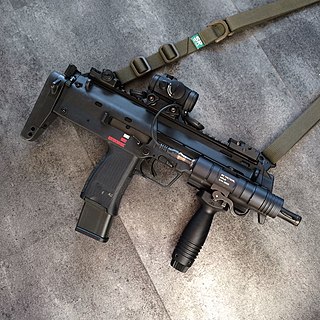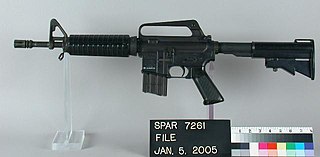
A carbine is a long gun that has a barrel shortened from its original length. Most modern carbines are rifles that are compact versions of a longer rifle or are rifles chambered for less powerful cartridges.

A firearm is any type of gun that uses an explosive charge and is designed to be readily carried and used by an individual. The term is legally defined further in different countries.

The M16 rifle is a family of military rifles adapted from the ArmaLite AR-15 rifle for the United States military. The original M16 rifle was a 5.56×45mm automatic rifle with a 20-round magazine.

A submachine gun (SMG) is a magazine-fed automatic carbine designed to fire handgun cartridges. The term "submachine gun" was coined by John T. Thompson, the inventor of the Thompson submachine gun, to describe its design concept as an automatic firearm with notably less firepower than a machine gun. As a machine gun must fire rifle cartridges to be classified as such, submachine guns are not considered machine guns.

The Colt AR-15 is a lightweight, magazine-fed, gas-operated semi-automatic rifle. It is a semi-automatic version of the M16 rifle sold for the civilian and law enforcement markets in the United States. The AR in AR-15 stands for ArmaLite rifle, after the company that developed it in the 1950s. Colt's Manufacturing Company currently owns the AR-15 trademark, which is used exclusively for its line of semi-automatic AR-15 rifles.

The M4 carbine is a 5.56×45mm NATO, select-fire, gas-operated, magazine-fed carbine developed in the United States during the 1980s. It is a shortened version of the M16A2 assault rifle.

The Browning Automatic Rifle (BAR) is a family of American automatic rifles and machine guns used by the United States and numerous other countries during the 20th century. The primary variant of the BAR series was the M1918, chambered for the .30-06 Springfield rifle cartridge and designed by John Browning in 1917 for the American Expeditionary Forces in Europe as a replacement for the French-made Chauchat and M1909 Benét–Mercié machine guns that US forces had previously been issued.

Personal defense weapons (PDWs) are a class of compact, magazine-fed, submachine gun-like automatic firearms designed to fire rifle-like cartridges. Most PDWs fire a small-caliber, high-velocity centerfire bottleneck cartridge resembling a scaled-down intermediate cartridge, essentially making them an "in-between" hybrid between a submachine gun and a carbine.

The ArmaLite AR-15 is a select-fire, gas-operated, air-cooled, magazine-fed rifle manufactured in the United States between 1959 and 1964. Designed by American gun manufacturer ArmaLite in 1956, it was based on its AR-10 rifle. The ArmaLite AR-15 was designed to be a lightweight rifle and to fire a new high-velocity, lightweight, small-caliber cartridge to allow infantrymen to carry more ammunition.

The Colt Automatic Rifle-15 or CAR-15 is a family of M16 rifle–based firearms marketed by Colt in the 1960s and early 1970s. However, the term "CAR-15" is most commonly associated with the Colt Commando ; these select-fire carbines have ultrashort 10.5-inch (270 mm) and 11.5-inch (290 mm) barrels with over-sized flash suppressors.

The Ultimax 100 is a Singapore-made 5.56mm light machine gun, developed by the Chartered Industries of Singapore by a team of engineers under the guidance of American firearms designer L. James Sullivan. The weapon is extremely accurate due to its constant-recoil operating system and is one of the lightest machine guns in the world.

A firearm is said to fire from an open bolt or open breech if, when ready to fire, the bolt and working parts are held to the rear of the receiver, with no round in the chamber. When the trigger is actuated, the bolt travels forward, feeds a cartridge from the magazine or belt into the chamber, and fires that cartridge in the same movement. Like any other self-loading design, the action is cycled by the energy released from the propellant, which sends the bolt back to the rear, compressing the mainspring in readiness for firing the next round. In an open-bolt gun firing semi-automatically, the bolt is caught and held at this point by the sear after each shot; and in automatic open-bolt fire, it's caught and held in this manner whenever the trigger is released. In contrast to this, in closed-bolt guns, the trigger and sear do not affect the movement of the bolt directly.

The Stoner 63 is a 5.56×45mm NATO modular weapon system. Using a variety of modular components, it can be configured as an assault rifle, carbine, top-fed light machine gun, belt-fed squad automatic weapon, or as a vehicle mounted weapon. Also known as the M63, XM22, XM23, XM207 or the Mk 23 Mod 0 machine gun, it was designed by Eugene Stoner in the early 1960s. Cadillac Gage was the primary manufacturer of the Stoner 63 during its history. The Stoner 63 saw very limited combat use by United States forces during the Vietnam War. A few were also sold to law enforcement agencies.

The Close Quarter Battle Receiver (CQBR) is a replacement upper receiver for the M4A1 carbine developed by the US Navy.

The two most common assault rifles in the world are the Soviet AK-47 and the American M16. These Cold War-era rifles have been used in conflicts both large and small since the 1960s. They are used by military, police, security forces, revolutionaries, terrorists, criminals, and civilians alike and will most likely continue to be used for decades to come. As a result, they have been the subject of countless comparisons and endless debate.
The Colt Automatic Rifle or Colt Light Machine Gun is a 5.56 mm NATO, open-bolt, full-automatic-only firearm developed by Colt Defense. It is based on the M16A2/A4, and has a distinctive squared-off handguard, vertical grip, carrying handle and integrated bipod.
The Colt Machine Gun or CMG was an open bolt belt-fed machine gun that fires 5.56×45mm cartridges designed by Colt Manufacturing Company in 1965. Colt hastily developed the CMG-1 to complement the CAR-15, a Colt branding of the M16 rifle, so that Colt might offer both of them as an alternative to the Stoner 63 weapons system. It failed to achieve any sales, and was replaced by the Colt CMG-2, which also failed to achieve any sales. The CMG-3 was a 7.62×51mm NATO version that failed as well.

The Colt 9mm SMG, also known as the Colt Model 635 or Colt M635, is a 9×19mm Parabellum submachine gun manufactured by Colt, based on the M16 rifle.

The M3 is an American .45-caliber submachine gun adopted by the U.S. Army on 12 December 1942, as the United States Submachine Gun, Cal. .45, M3. The M3 was chambered for the same .45 ACP round fired by the Thompson submachine gun, but was cheaper to mass produce and lighter, at the expense of accuracy. The M3 was commonly referred to as the "Grease Gun" or simply "the Greaser," owing to its visual similarity to the mechanic's tool.


















